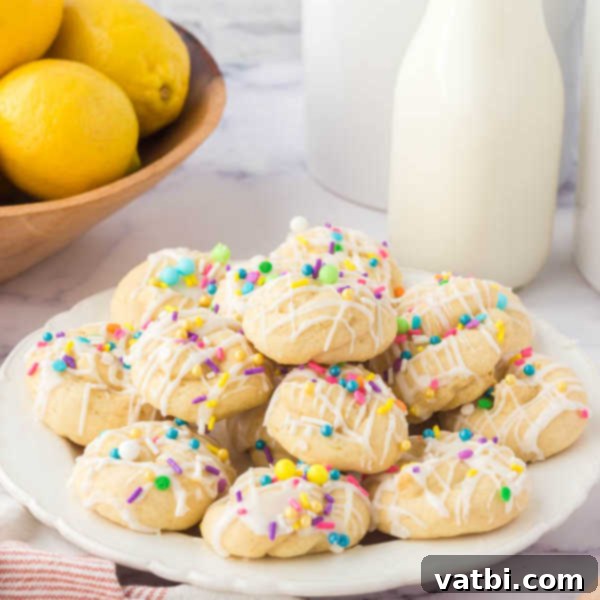Delicious Italian Easter Cookies with Lemon Glaze: A Festive Tradition
Celebrate the joy of Easter with these delightful Italian Easter Cookies, featuring a hint of sweetness and a refreshingly tangy lemon glaze. These charming knot-shaped cookies are not only easy to bake but also beautifully adorned with colorful pastel sprinkles, making them a perfect addition to your holiday spread. Their delicate flavor and festive appearance make them an ideal treat for family gatherings, brunches, or simply enjoying with a cup of coffee.

These traditional Italian cookies are a cherished part of many Easter celebrations, bringing both aesthetic appeal and a wonderful taste to the table. They are incredibly versatile and can be enjoyed as a sweet finish to a meal or as a lighter accompaniment to an Easter brunch. I’ve been making this particular recipe for years, and it always receives rave reviews for its delicious flavor and charming presentation. Beyond these festive treats, you might also enjoy preparing other holiday favorites like an Easter Cookie Cake, whimsical Peeps Rice Krispie Treats, or classic Easter Rice Krispie Treats. For those seeking another decadent Italian dessert, my Cannoli Cake recipe is a must-try.
Table of contents
- Why We Love These Italian Easter Cookies
- Key Ingredients for Success
- For the Cookies
- For the Glaze
- Variations and Substitutions
- How to Make Italian Easter Cookies
- Proper Storage for Freshness
- Expert Baking Tips
- Frequently Asked Questions (FAQ)
- More Easter Dessert Recipes
Why We Love These Italian Easter Cookies
There’s so much to adore about these traditional Italian Easter Cookies. They strike a perfect balance, offering a delightful sweetness that isn’t overwhelming, making them suitable not only as a dessert but also for a festive brunch spread. The star of the show is undeniably the fresh, vibrant lemon glaze, which infuses each bite with a bright, zesty flavor that perfectly complements the subtle sweetness of the cookie itself.
These delicious knot cookies are a common sight during the Easter season in Italian households. You might hear them affectionately called “Taralli Dolci,” a term often used for sweet, ring-shaped biscuits. Another charming name for these treats is “Uncinetti,” which is Italian for crochet. This name stems from their distinctive knotted shape, which is said to resemble a crochet knot – a simple yet elegant detail that adds to their homemade charm.
What truly makes these cookies pop for Easter are the pretty pastel sprinkles. They transform a simple cookie into a truly festive centerpiece, capturing the lighthearted spirit of spring and the holiday. The powdered sugar glaze, infused with fresh lemon, provides a smooth, slightly crisp coating that everyone will find utterly irresistible. It’s a classic recipe that combines tradition, flavor, and visual appeal into one perfect package.
Key Ingredients for Success
Crafting the perfect batch of Italian Easter Cookies begins with selecting quality ingredients. Each component plays a vital role in achieving the desired texture, flavor, and overall deliciousness of these beloved treats. Here’s a closer look at the key elements for both the cookies and their signature lemon glaze.
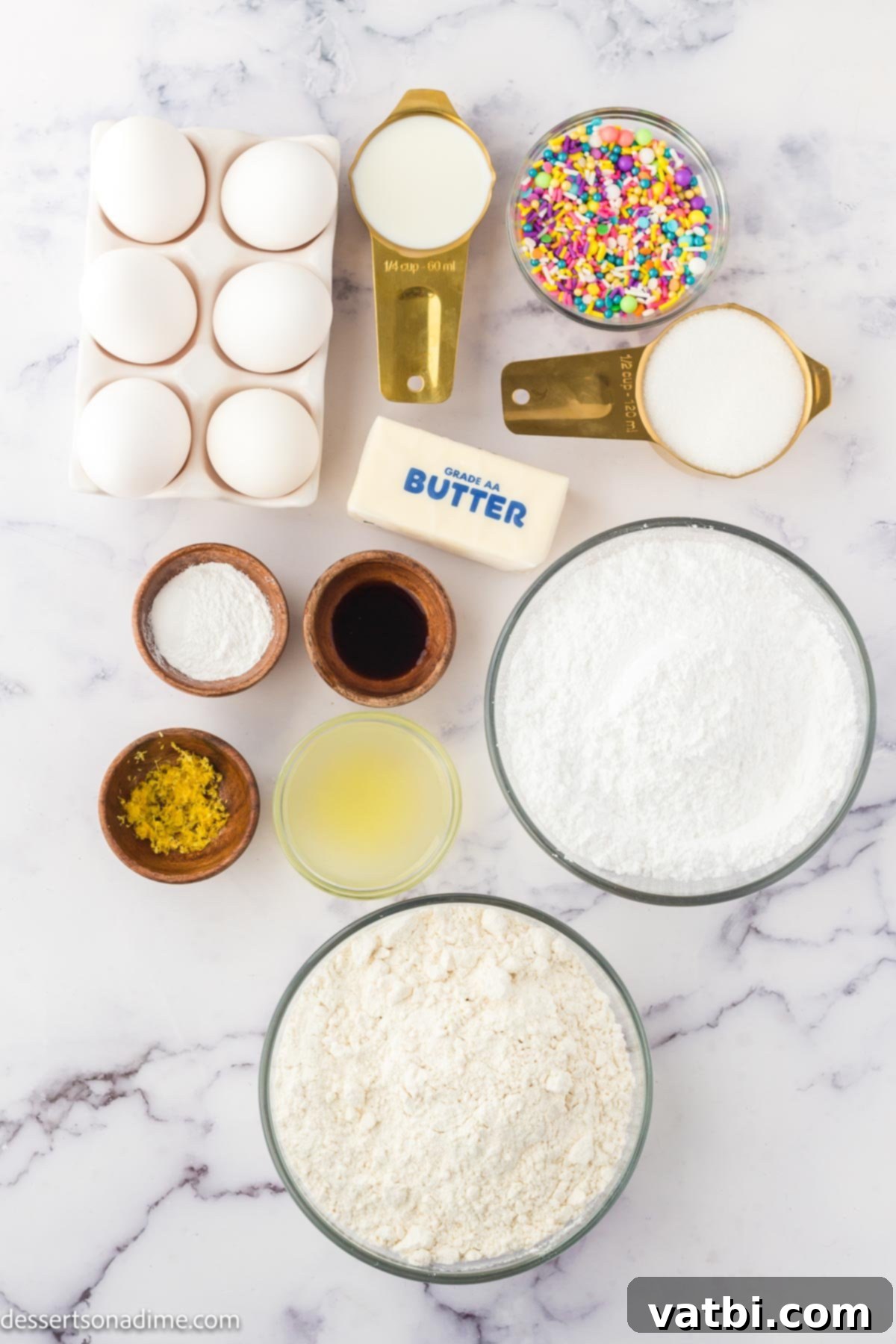
For the Cookies
- All-Purpose Flour: The foundational ingredient, providing structure to the cookies. Ensure it’s measured correctly for the best texture.
- Unsalted Butter: Essential for richness and tender crumb. Make sure it’s softened at room temperature for easy creaming, which helps incorporate air for a lighter cookie.
- Granulated Sugar: Sweetens the cookies and contributes to their delicate texture.
- Large Eggs: Act as a binder, adding moisture and richness. Ensure they are at room temperature to emulsify properly with the butter and sugar.
- Pure Vanilla Extract: A classic flavor enhancer that adds warmth and depth to the cookies. Always opt for pure vanilla for superior taste.
- Lemon Zest: The secret to that bright, fresh citrus taste within the cookie dough. Zesting a fresh lemon provides a much more potent and authentic flavor than extract alone.
- Baking Powder: Our leavening agent, ensuring the cookies rise lightly and have a pleasant, slightly airy texture.
- Milk: Adds moisture to the dough, helping to create a tender, pliable consistency for shaping.
- Salt: A crucial ingredient that balances the sweetness and enhances all the other flavors in the cookie.
For the Glaze
- Powdered Sugar: The base for our smooth, sweet glaze. It is absolutely essential to sift the powdered sugar before mixing to prevent any lumps and ensure a silky-smooth finish.
- Fresh Lemon Juice: Provides the characteristic tartness and bright flavor of the glaze. Freshly squeezed lemon juice is paramount for the best and most vibrant taste.
- Milk: Used to adjust the consistency of the glaze, allowing you to achieve your desired thickness for dipping or drizzling.
- Multi-Color Pastel Sprinkles: These festive sprinkles add a pop of color and a touch of holiday cheer, making the cookies visually appealing for Easter.
The complete ingredient list with precise measurements and the full recipe card can be found conveniently at the bottom of this page. Gather your ingredients, and let’s get baking!
Variations and Substitutions
While the classic lemon-glazed Italian Easter Cookies are utterly delicious, there’s plenty of room to get creative and customize them to your liking or for different occasions. Here are some ideas for variations and substitutions to inspire your baking:
- Explore Different Extracts: The flavor profile of these cookies can be wonderfully altered with different extracts. Beyond vanilla, consider adding or substituting:
- Almond Extract: For a more traditional Italian cookie flavor, often paired with vanilla.
- Anise Extract: Offers a distinct licorice-like taste, very popular in many traditional Italian cookies.
- Orange Extract or Zest: If you prefer orange over lemon, this offers a delightful citrus twist. You can even use a combination of lemon and orange zest for a dual citrus punch.
- Vanilla Bean Paste: For a richer, more intense vanilla flavor and those beautiful speckles.
You might even like to use a combination of both vanilla and almond extracts together for a complex and aromatic cookie.
- Experiment with Sprinkles for Any Occasion: While pastel sprinkles are perfect for Easter, these cookies are so delightful you’ll want to enjoy them all year round! Simply swap out the sprinkles to match any holiday or celebration:
- Christmas: Red and green sprinkles, or silver and gold.
- Halloween: Orange, black, and purple sprinkles.
- Birthdays: Rainbow sprinkles or colors matching the party theme.
- Fourth of July: Red, white, and blue sprinkles.
- No sprinkles: For a more elegant, simple look, simply leave them plain or add a dusting of lemon zest.
- Add Food Coloring to the Glaze: Unleash your inner artist by adding any color of food dye to the glaze. This is especially fun for Easter, where you can create a variety of pastel shades resembling Easter eggs. Think soft pinks, baby blues, mint greens, or sunny yellows. Start with a tiny drop and add more until you reach your desired hue.
- Incorporate Chopped Nuts: For an added layer of texture and flavor, finely chop some almonds, pistachios, or walnuts and fold them into the cookie dough. This adds a delightful crunch and nutty undertone.
- Lemon Poppy Seed Twist: Add 1-2 tablespoons of poppy seeds to the cookie dough for a classic lemon poppy seed flavor and visual appeal.
These variations allow you to personalize your Italian Easter Cookies, making them uniquely yours for any festive occasion or simply for an everyday treat.
How to Make Italian Easter Cookies
Making these charming Italian Easter Cookies is a straightforward and enjoyable process. Follow these detailed steps to create perfectly tender, lemon-glazed knot cookies that will impress everyone.
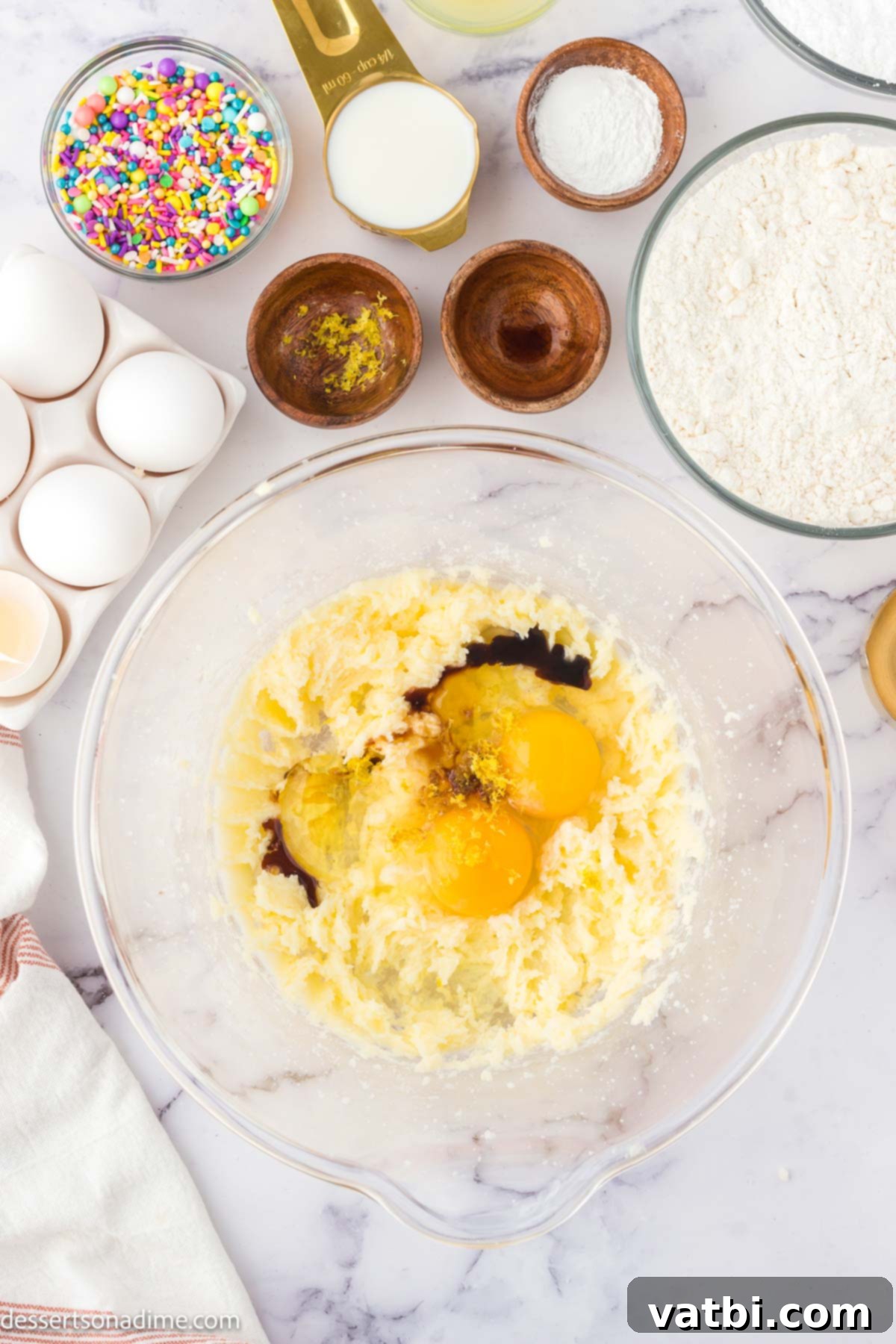
Step 1: Cream Wet Ingredients. In the bowl of a stand mixer fitted with a paddle attachment, or using a hand mixer, cream together the softened butter and granulated sugar. Beat until the mixture is light, fluffy, and well combined, which typically takes a few minutes. This step is crucial for incorporating air into the dough, leading to a tender cookie. Next, add the eggs one at a time, followed by the vanilla extract and lemon zest. Continue mixing until everything is fully incorporated and the mixture is smooth. Scrape down the sides of the bowl as needed to ensure even mixing.
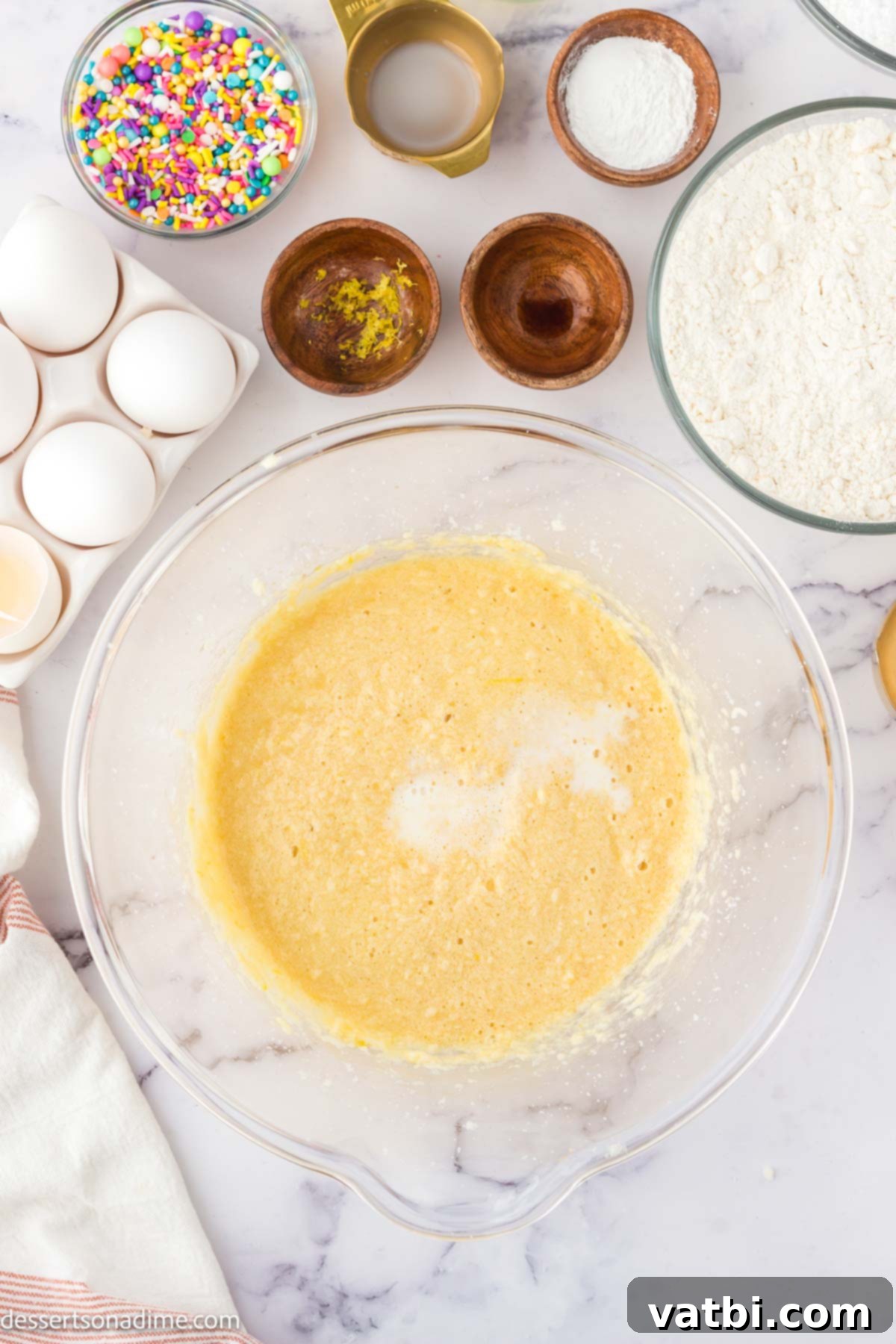
Step 2: Add Milk. With the mixer on low speed, gradually add the milk to the wet ingredients. Mix until it is just combined. Be careful not to overmix at this stage; you just want to ensure the milk is fully incorporated into the mixture.
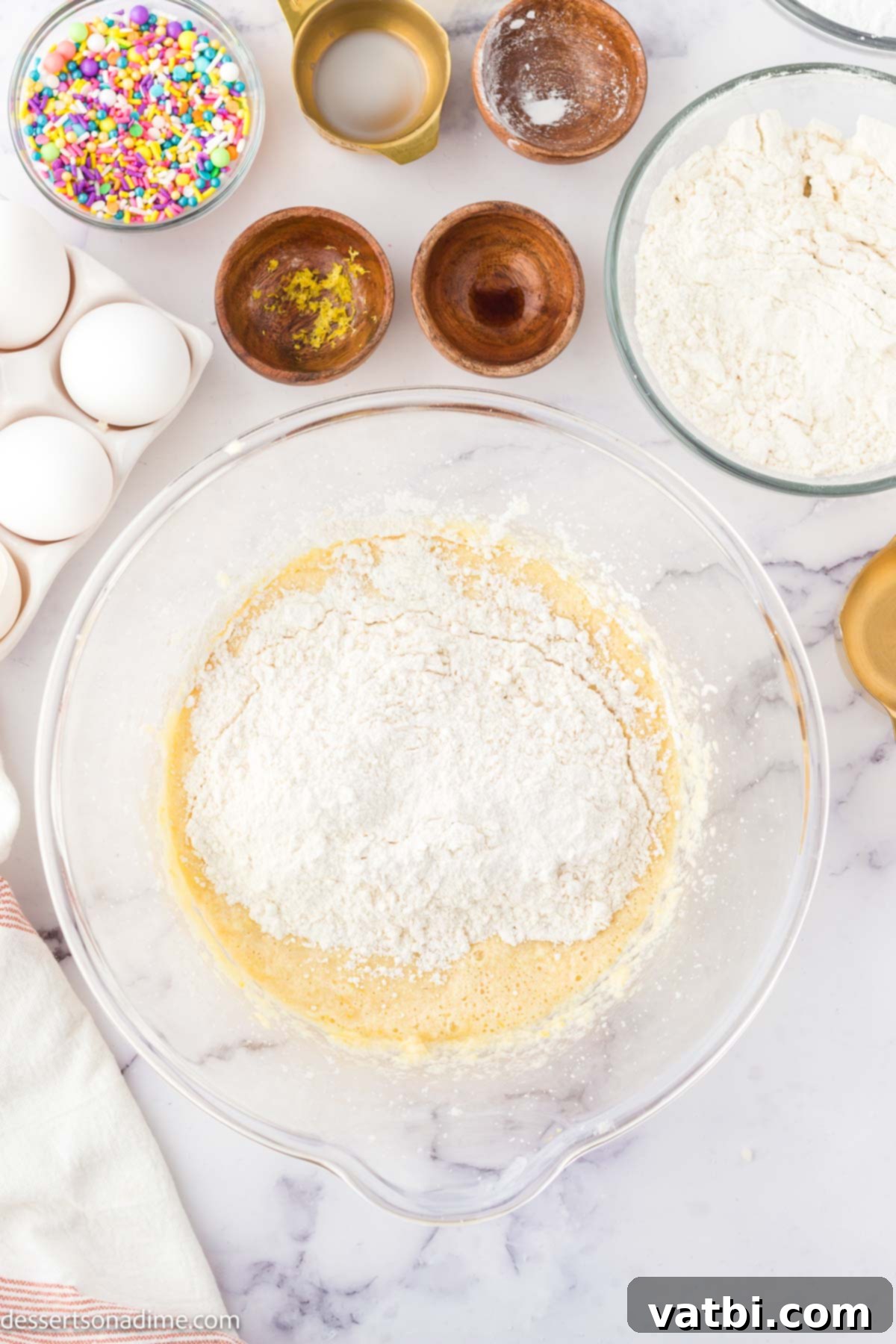
Step 3: Combine Dry Ingredients. In a separate, medium-sized bowl, whisk together the all-purpose flour, baking powder, and salt. Make sure these dry ingredients are thoroughly combined to ensure the leavening agent is evenly distributed throughout the dough.
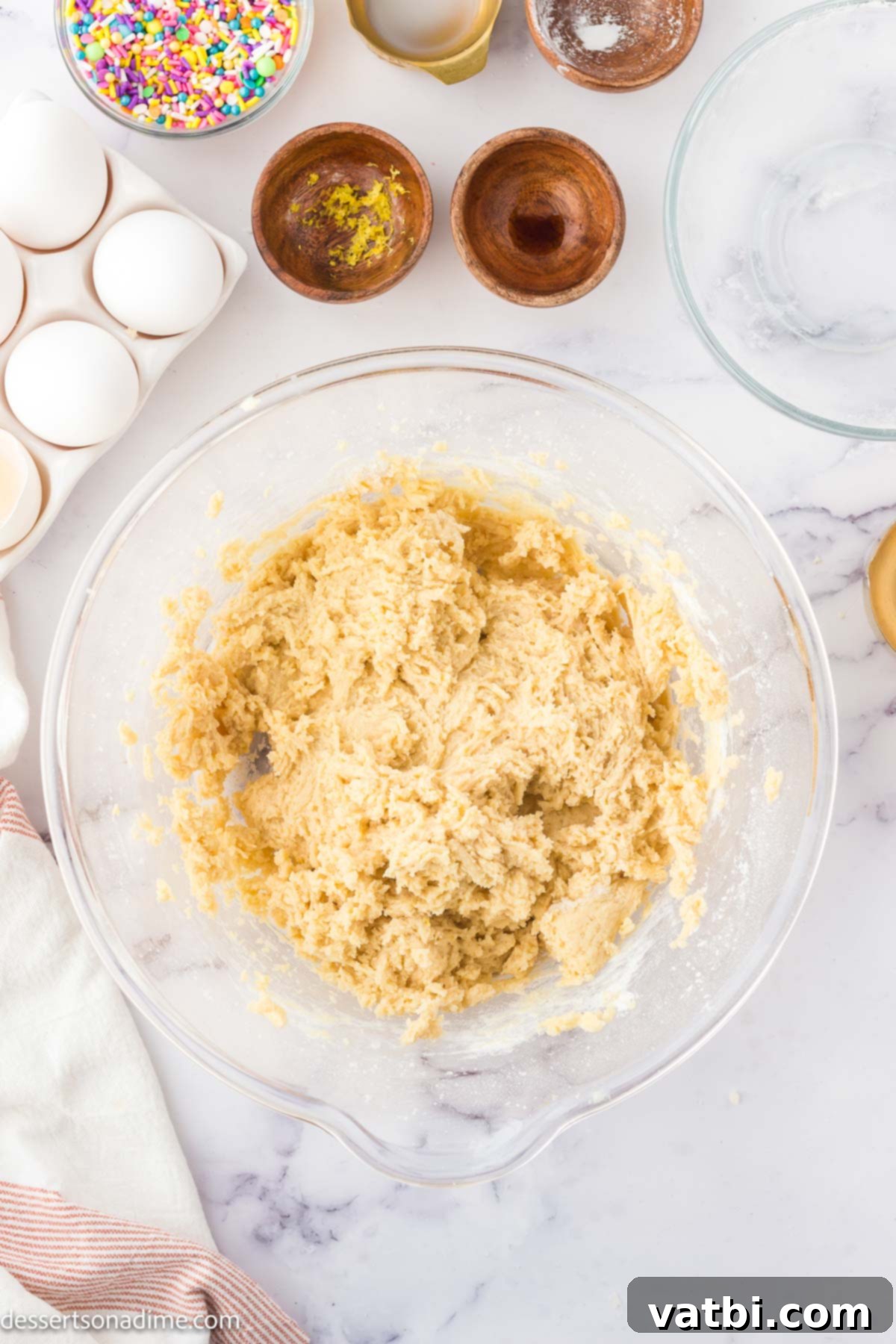
Step 4: Gradually Mix Dry into Wet. Gradually add the dry ingredient mixture to the wet mixture in the stand mixer bowl. Mix on low speed until the ingredients are just combined and a soft dough forms. It is crucial not to overmix the dough, as this can lead to tough cookies. Once combined, cover the bowl with plastic wrap and refrigerate the dough. It needs to chill for at least one hour, or ideally, overnight. Chilling makes the dough easier to handle and prevents the cookies from spreading too much during baking.
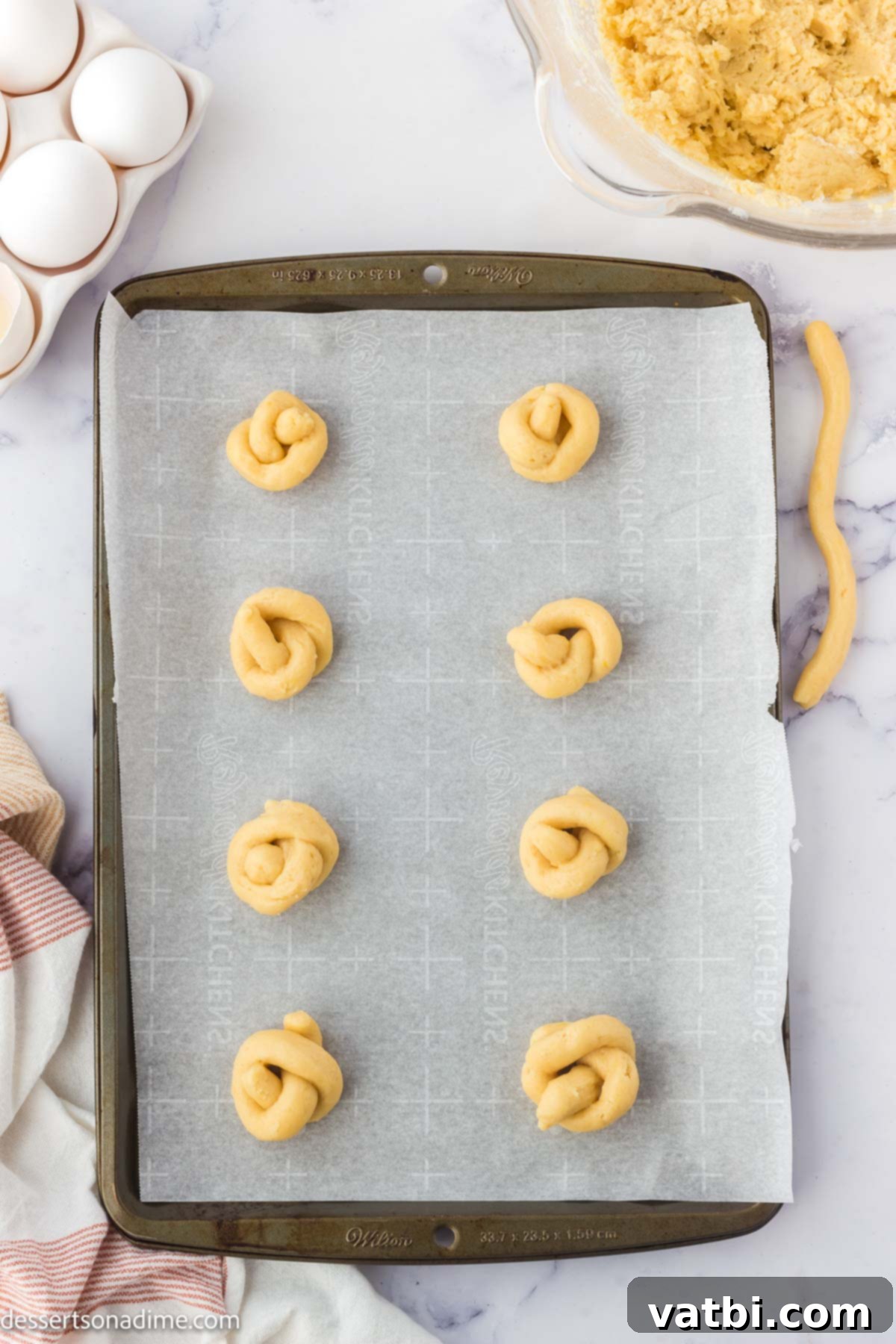
Step 5: Shape the Cookies. Once the dough is properly chilled, preheat your oven to 300°F (150°C) and line baking sheets with parchment paper for easy cleanup. Take small pieces of the cookie dough from the bowl and roll them into thin ropes, about 5 to 6 inches long. Remember, these ropes should be relatively thin because the cookies will expand and rise as they bake. Once you have a rope, form it into a loose knot shape. Place the formed knot cookies about 1-2 inches apart on the prepared baking sheets.
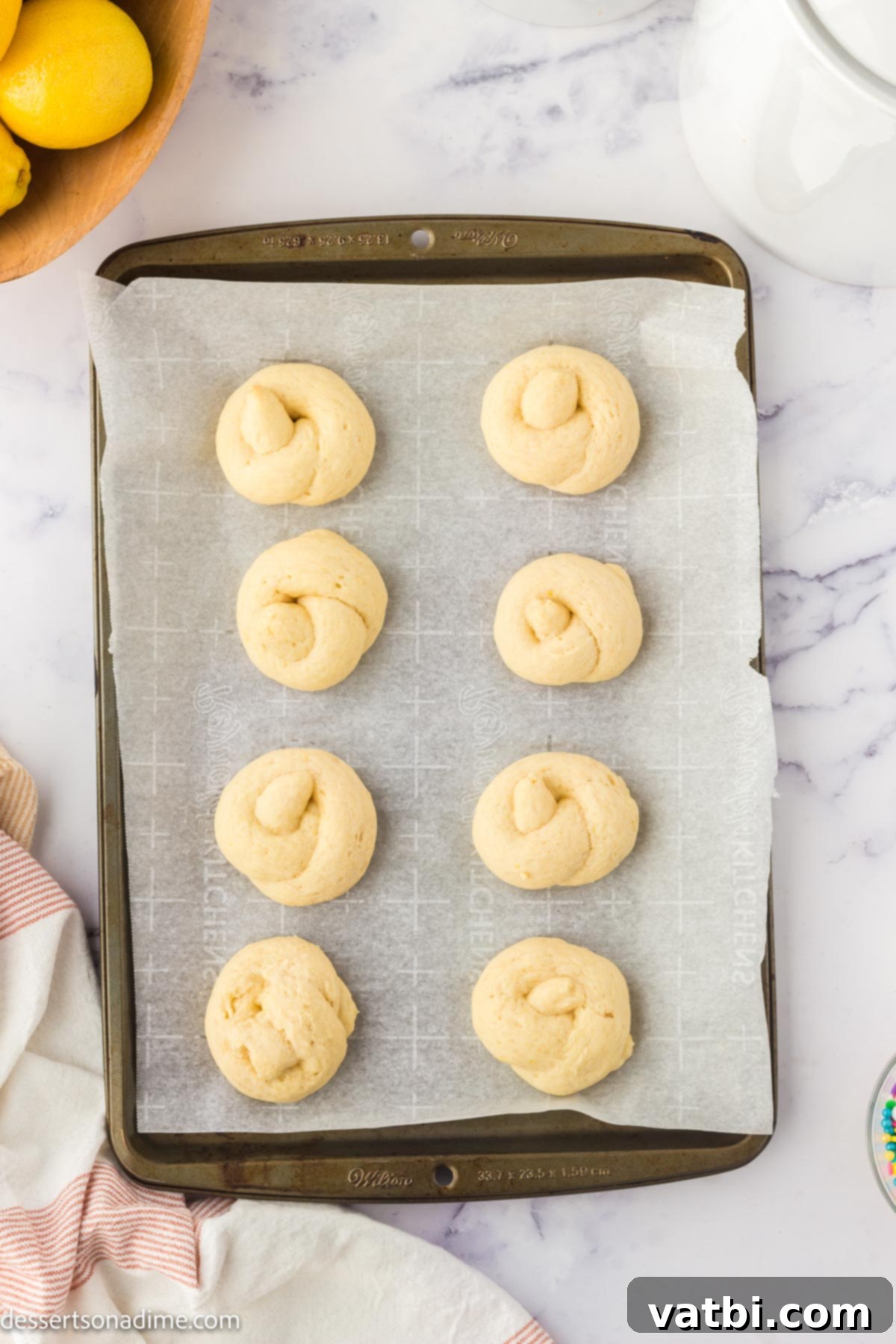
Step 6: Bake and Prepare Glaze. Place the baking sheets with the shaped cookies into the preheated oven. Bake for 15 to 18 minutes, or until the edges are lightly golden brown. The cookies should be firm to the touch but still soft in the center. While the cookies are baking, seize this opportunity to prepare the delicious lemon glaze. In a large bowl, whisk together the sifted powdered sugar, fresh lemon juice, and a tablespoon of milk until smooth and free of lumps. Adjust the milk gradually to reach your desired consistency – a thicker glaze will be more opaque, while a thinner glaze will be more translucent.
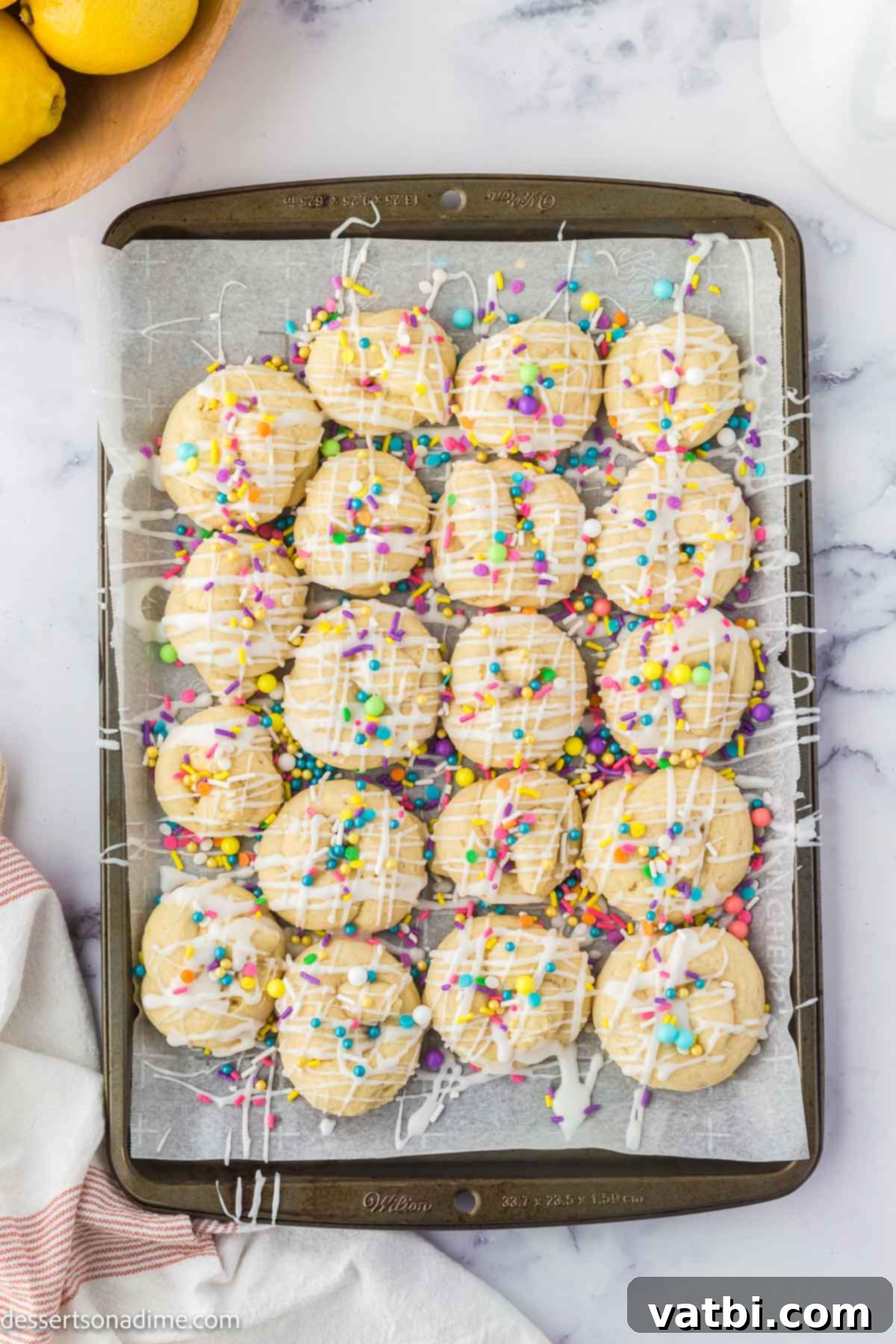
Step 7: Glaze and Cool. Once baked, remove the cookies from the oven and let them cool on the baking sheet for about 5 minutes. Then, carefully transfer them to a wire rack to cool completely. Allowing them to cool fully is essential before glazing. Once cool, generously dip each cookie into the prepared lemon glaze, or use a spoon to drizzle the glaze over them. Ensure they are evenly coated for that perfect flavor and appearance.
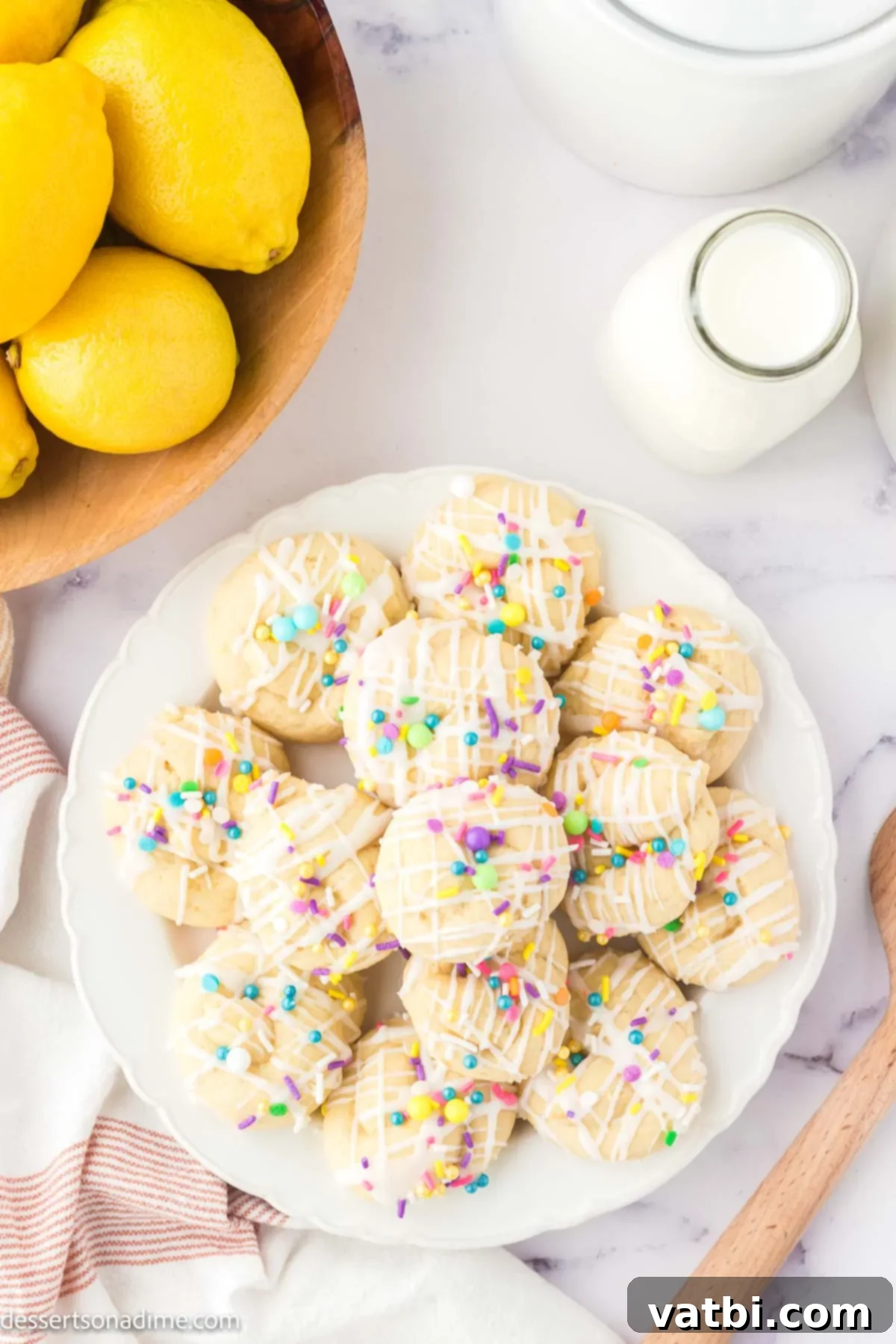
Step 8: Add Sprinkles and Enjoy. Immediately after glazing each cookie, generously sprinkle with your chosen pastel sprinkles. The glaze will set relatively quickly, so it’s important to add the sprinkles while the icing is still wet to ensure they stick properly. Allow the glaze to fully set and harden before stacking or storing the cookies. Once set, arrange them on a platter and enjoy these beautiful and delicious Italian Easter Cookies!
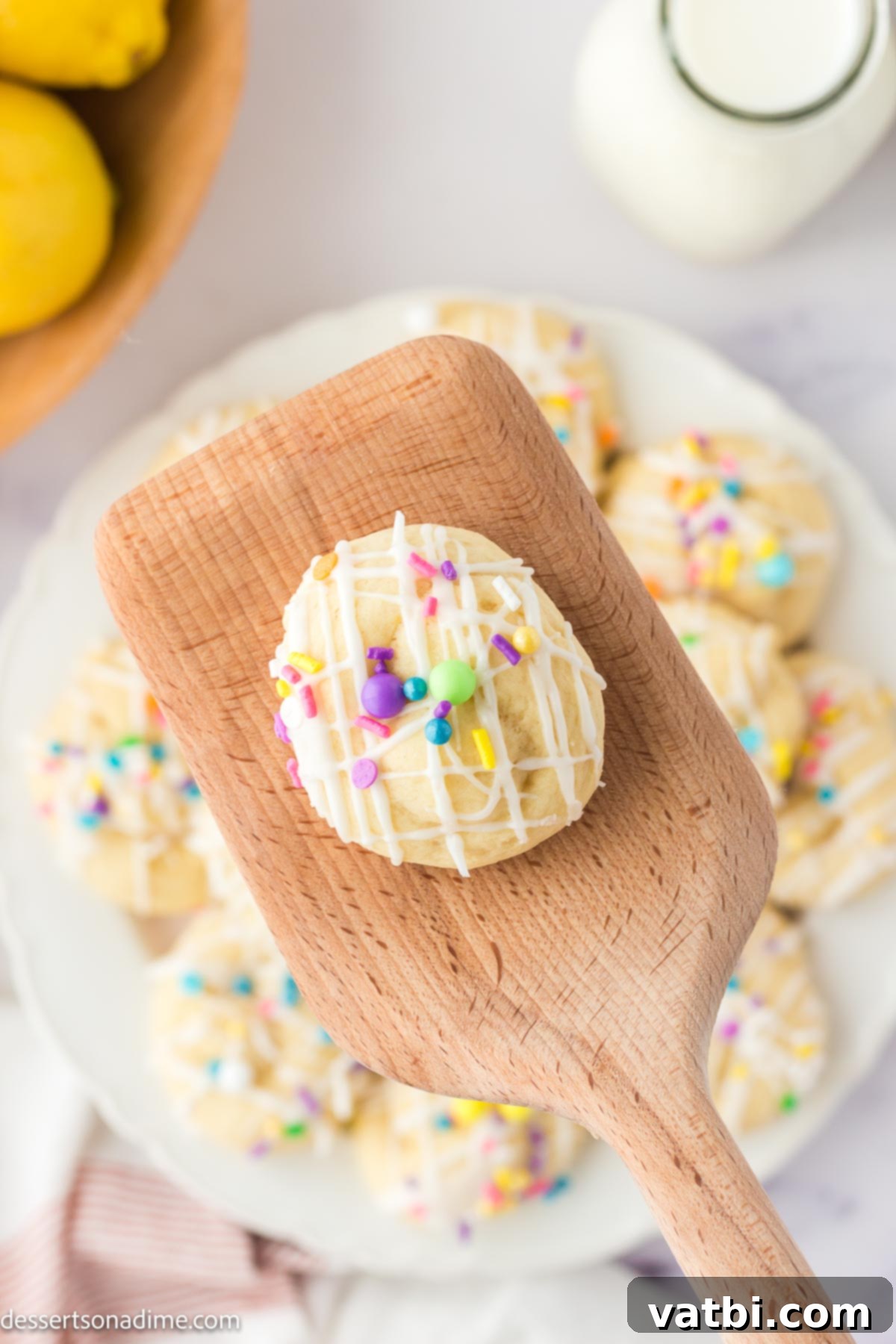
Proper Storage for Freshness
To ensure your delicious Italian Easter Cookies remain fresh and enjoyable for as long as possible, proper storage is key. Following these simple guidelines will help maintain their wonderful taste and texture:
Once your cookies have been baked and glazed, it is crucial to allow them to cool completely and for the glaze to fully set and harden. This step is non-negotiable! If you attempt to store the cookies before the glaze is firm, they will stick together in the container, potentially ruining their beautiful appearance and making them difficult to separate. The glaze needs to form a protective, slightly crisp shell.
After the glaze has thoroughly set, gently place the cookies inside an airtight container. A single layer is best to prevent sticking, but if you must stack them, place a sheet of parchment paper between layers to protect the glaze and sprinkles. Stored this way at room temperature, your Italian Easter Cookies will remain fresh and flavorful for up to 1 week.
For an extra tip to help keep your cookies wonderfully moist for longer, you can place a slice of fresh bread in the airtight container with them. The cookies will absorb moisture from the bread, preventing them from drying out. Just be sure to replace the bread every couple of days to keep it fresh. This simple trick can make a noticeable difference in the longevity of their tender texture.
Expert Baking Tips
Achieving bakery-quality Italian Easter Cookies is easier than you think with these expert tips:
- Line Baking Sheets for Easy Cleanup: Always line your baking sheets with parchment paper or a silicone baking mat. This not only prevents the cookies from sticking but also makes cleanup incredibly easy, especially when dealing with any errant glaze or sprinkles. It also helps with more even baking by providing a consistent surface.
- Add Sprinkles Immediately: The lemon sugar icing will begin to set and harden quite quickly once applied to the warm or cooled cookies. To ensure your festive sprinkles adhere properly and don’t just fall off, apply them generously right after you glaze each cookie. Work quickly, or glaze a few cookies at a time before sprinkling.
- Roll the Ropes Thin: When shaping the dough into ropes, remember that the cookies will rise and expand significantly during baking due to the leavening agent. Therefore, it’s essential to roll the dough ropes quite thin, typically around ½ inch in diameter. If the ropes are too thick, your finished knot cookies will be overly large and dense, and the knot shape might not be as defined. Aim for a delicate appearance.
- Room Temperature Ingredients are Key: Ensure your butter, eggs, and milk are all at room temperature before you begin mixing. Room temperature ingredients emulsify much better, creating a smooth, cohesive dough that bakes more evenly and yields a superior texture.
- Do Not Overmix the Dough: After adding the dry ingredients to the wet, mix only until just combined. Overmixing develops the gluten in the flour, which can lead to tough, chewy cookies instead of the desired tender texture.
- Chill the Dough Thoroughly: Do not skip the chilling step! Refrigerating the dough for at least an hour (or overnight) firms up the butter, which prevents the cookies from spreading too much in the oven. It also makes the dough much easier to handle and shape into neat knots.
- Sift Powdered Sugar for Glaze: Always sift your powdered sugar for the glaze. This simple step removes any lumps, ensuring you achieve a perfectly smooth, silky, and professional-looking glaze without any gritty texture.
Frequently Asked Questions (FAQ)
Here are some common questions about making Italian Easter Cookies:
- Are Italian Easter Cookies soft or crispy?
These cookies are generally soft and tender with a slightly cake-like texture. The glaze, once set, provides a delicate, slightly crisp outer layer that complements the soft interior.
- Can I make the cookie dough ahead of time?
Absolutely! The cookie dough can be made up to 2-3 days in advance and stored, tightly covered, in the refrigerator. In fact, chilling the dough overnight can often enhance the flavors and make it even easier to handle for shaping.
- What is “Taralli Dolci”?
Taralli Dolci refers to sweet taralli, which are traditional Italian biscuits. While many taralli are savory, Taralli Dolci are sweet and often glazed, much like these Easter knot cookies. The term can encompass various shapes, including rings and knots.
- Can I use orange zest instead of lemon?
Yes, you can! Orange zest and orange juice make a fantastic alternative if you prefer an orange flavor or want to try a different citrus profile. The method for making the cookies and glaze remains the same.
- Why are my cookies spreading too much in the oven?
Cookies spreading too much can be due to a few factors: the butter being too warm, not chilling the dough long enough, or adding too much liquid or not enough flour. Ensure your butter is softened but not melted, and always chill the dough for the recommended time to help it hold its shape.
- Can I freeze Italian Easter Cookies?
Yes, you can! You can freeze the baked and glazed cookies by placing them in a single layer on a baking sheet until frozen solid, then transferring them to an airtight freezer-safe container or bag. They can be frozen for up to 3 months. Thaw at room temperature. You can also freeze the unbaked dough. Wrap it tightly in plastic wrap and then foil, and freeze for up to 3 months. Thaw in the refrigerator before shaping and baking.
More Easter Dessert Recipes
If you’re looking for more festive treats to complete your Easter celebration, explore these other delightful dessert recipes:
- Easter Chocolate Covered Oreos: Easy to make and always a crowd-pleaser, these Oreos are dipped in colorful chocolate and decorated for Easter.
- Birds Nest Cookies Recipe: Adorable no-bake cookies that resemble bird nests, complete with candy eggs. Perfect for a themed Easter dessert!
- Easter Dirt Cups Recipe: A fun, kid-friendly dessert layered with crushed cookies, pudding, and festive toppings that mimic “dirt” and spring growth.
- Best Easter Dessert Recipes: A collection of our top-rated desserts specifically curated for the Easter holiday, offering a variety of choices for every taste.
- Easter Bunny Chow: A sweet, crunchy, and addictive snack mix, also known as muddy buddies, given an Easter twist with pastel colors and candies.
- Crock Pot Easter Candy Clusters: An incredibly simple recipe for chocolate and candy clusters made in a slow cooker, ideal for holiday gifting or easy entertaining.
I genuinely can’t wait for you to try making these wonderful Italian Easter Cookies. They truly embody the spirit of the season with their beautiful appearance and delicious taste. Once you’ve had a chance to bake them, please come back and leave a star rating to share your experience!
Pin
Italian Easter Cookies
Ingredients
FOR THE COOKIES:
- 2 1/2 cup All Purpose Flour
- 1/2 cup Butter softened
- 1/2 cup Granulated Sugar
- 3 Large Eggs
- 2 tsp Vanilla Extract
- Zest of 1 Lemon
- 1 Tbsp Baking Powder
- 1/4 cup Milk
- 1/4 tsp Salt
FOR THE GLAZE:
- 2 cups Powdered Sugar shifted
- 2 Tbsp Lemon Juice fresh
- 1 Tbsp Milk
- Multi-Color Pastel Sprinkles
Instructions
-
Beat together the butter and sugar in a stand up mixer or with a hand held mixer until the ingredients are creamed together and smooth.
-
Then add in the eggs, vanilla extract and lemon zest. Mix until combined and light and fluffy.
-
Then add in the milk and mix until incorporated.
-
In a separate bowl, mix together the flour, baking powder, and salt together. Then gradually add these dry ingredients into the wet ingredients. Mix together until the ingredients are just combined – do not over mix.
-
Then cover the dough and refrigerate for at least 1 hour or overnight.
-
Then preheat the oven to 300 degrees F and line a baking sheet with parchment paper.
-
Remove pieces of dough from the bowl and roll into 5-6 inch long ropes (the ropes should be thin as they will rise as they bake). Then form knots out of the dough ropes. Place the formed knot cookies on the baking sheet and bake for 15-18 minutes until the cookies are lightly golden brown.
-
Let the cookies cool on the baking sheet for 5 minutes and then move the cookies to a wire rack to cool completely.
-
While the cookies are cooling, make the glaze. In a bowl, stir together the powdered sugar, lemon juice and milk.
-
Once the cookies are cool, cover them with the glaze and top with the pastel sprinkles.
-
Enjoy!
Recipe Notes
Nutrition Facts
Pin This Now to Remember It Later
Pin Recipe
